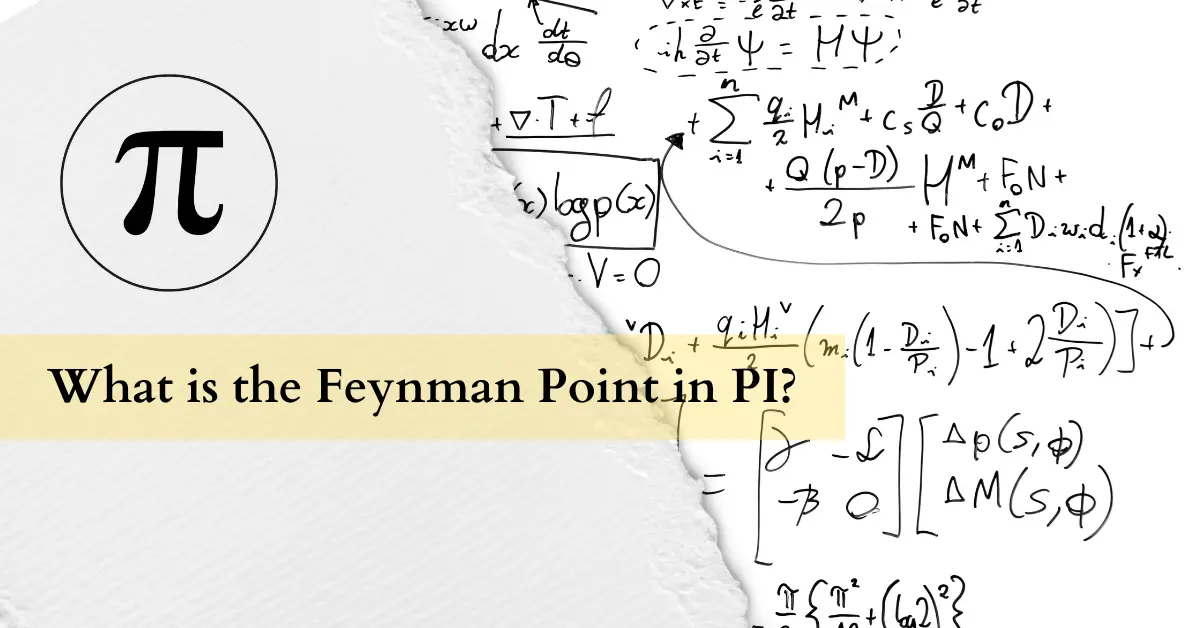In mathematics, Pi (π) stands as a symbol of both simplicity and complexity. Defined as the ratio of a circle’s circumference to its diameter, Pi holds an infinite decimal expansion. Among its infinite digits lies a curious sequence known as the Feynman Point, named after the renowned physicist Richard Feynman. This enigmatic pattern has intrigued mathematicians and enthusiasts alike, sparking curiosity about its significance and the effectiveness of the Feynman Technique in understanding complex concepts.
What Is the Feynman Point in Pi?
The Feynman Point refers to a six-digit sequence of consecutive nines (999999) occurring in the decimal expansion of Pi, precisely at the 762nd decimal place. This occurrence is noteworthy due to its seemingly random placement within Pi’s infinite digits.
While Pi’s digits are believed to be infinitely non-repeating and random, the appearance of the Feynman Point raises questions about the distribution and patterns within Pi’s decimal expansion.
Richard Feynman, a Nobel laureate physicist renowned for his contributions to quantum mechanics and theoretical physics, became associated with this peculiar sequence due to his fascination with Pi and its properties.
Despite its seemingly arbitrary nature, the Feynman Point has captured the imagination of mathematicians and inspired discussions about the nature of randomness within mathematical constants.
Also read: What is Protecting Americans from Foreign Adversary Controlled Applications Act? What is H.R.7521?
The Feynman Technique
Beyond the world of mathematics, the Feynman Technique emerges as a powerful pedagogical method for learning and understanding complex concepts. Named after Richard Feynman himself, this technique emphasizes the importance of simplifying and explaining concepts in plain language to enhance comprehension. The technique involves four key steps:
- Choose a Concept: Select a concept or topic you wish to understand deeply.
- Teach it to a Child: Break down the concept into simple terms and explain it as if you were teaching it to a young child. Use analogies, examples, and everyday language to convey the essence of the concept.
- Identify Knowledge Gaps: As you explain the concept, pay attention to areas where your understanding falters or where you struggle to articulate clearly. These gaps indicate areas that require further study and clarification.
- Review and Simplify: Consolidate your understanding by reviewing the concept and refining your explanations. Simplify complex ideas, fill in knowledge gaps, and strive for clarity in your understanding.
Let’s use an example to understand the Feynman technique.
As said earlier, first choose a concept. Let’s say the concept is photosynthesis.
So, what is Photosynthesis? It is the process by which green plants, algae, and some bacteria convert light energy into chemical energy in the form of glucose, using carbon dioxide and water.
Imagine explaining photosynthesis to a child! How will you do it?
You will explain in a manner like “Okay, imagine plants are like little factories that make their own food. But instead of going to a grocery store like we do, they make their food using sunlight, air, and water!
So, there are these tiny green things called chlorophyll in the leaves of plants, and they’re like little magic wands that capture sunlight. Then, the plant sucks up water from the ground through its roots, and it breathes in carbon dioxide from the air, kind of like how we breathe in air.
Then, using sunlight as their power, the plants mix all these things together like ingredients in a recipe, and voila! They make their own food, which is called glucose. And just like how we need food to grow and be healthy, plants need glucose to grow big and strong!”
Now identify the knowledge gaps while explaining the concept. When you were elaborating photosynthesis, you might have realized that you’re not entirely sure about the role of chlorophyll or the specific chemical reactions involved in the process.
These gaps indicate areas that require further study and clarification.
After identifying knowledge gaps, you can review the concept of photosynthesis in more detail. You might use resources like textbooks, online articles, or educational videos to deepen your understanding of chlorophyll’s role and the chemical reactions involved in photosynthesis.
Once you’ve clarified these points, you can simplify your explanation further and ensure that you can explain photosynthesis confidently to anyone, using clear and straightforward language.
The Feynman technique helps you enhance your understanding of complex concepts and improve your ability to explain them clearly to others.
How Effective Is the Feynman Technique?
Numerous studies and anecdotal evidence attest to the effectiveness of the Feynman Technique in enhancing learning and retention. By breaking down complex concepts into digestible chunks and teaching them in simple terms, learners can solidify their understanding and identify areas for improvement.
The act of explaining concepts forces individuals to confront their own understanding and fill in gaps in knowledge, leading to deeper comprehension and mastery.
Moreover, the Feynman Technique fosters active engagement with the material, promoting critical thinking and long-term retention. By encouraging learners to articulate their understanding in their own words, the technique facilitates deeper encoding of information and strengthens neural connections associated with learning.
The Feynman Technique I Sprouts
Conclusion
The Feynman Point in Pi serves as a captivating mathematical curiosity, highlighting the intricate beauty and complexity of mathematical constants. While its appearance within Pi’s infinite digits may appear random, the fascination it evokes underscores humanity’s enduring quest to unravel the mysteries of the universe.
In parallel, the Feynman Technique offers a powerful approach to learning and understanding complex concepts, transcending disciplinary boundaries to empower learners across various domains.
By embracing simplicity, clarity, and active engagement, individuals can unlock the secrets of the universe and embark on a journey of lifelong learning and discovery.
Content Contributor: Rehana Sengupta with Sudhanshu Solanki (M.Sc, Mathematics)









